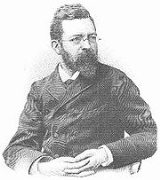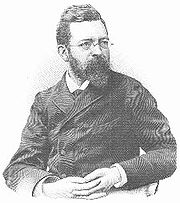
Pierre de Nolhac
Encyclopedia

Ambert
-Places of interest:Ambert is famous for its fourme-d'Ambert cheese, its paper mills and its circular town hall ....
, 15 December 1859 - Paris, 31 January 1936), known as Pierre de Nolhac, was a French historian, art historian and poet.
Life
After studying at Le Puy-en-VelayLe Puy-en-Velay
Le Puy-en-Velay is a commune in the Haute-Loire department in south-central France.Its inhabitants are called Ponots.-History:Le Puy-en-Velay was a major bishopric in medieval France, founded early, though its early history is legendary...
, in Rodez and Clermont-Ferrand
Clermont-Ferrand
Clermont-Ferrand is a city and commune of France, in the Auvergne region, with a population of 140,700 . Its metropolitan area had 409,558 inhabitants at the 1999 census. It is the prefecture of the Puy-de-Dôme department...
, Pierre de Nolhac went to Paris in 1880 to undertake a literature degree at the Sorbonne and the École pratique des hautes études
École pratique des hautes études
The École pratique des hautes études is a Grand Établissement in Paris, France. It is counted among France's most prestigious research and higher education institutions....
, where he later became director of studies. A Member of the French School of Rome in 1882, he worked there on Italian humanism of the sixteenth century. In 1886 he was attached to the Museum in the Palace of Versailles
Palace of Versailles
The Palace of Versailles , or simply Versailles, is a royal château in Versailles in the Île-de-France region of France. In French it is the Château de Versailles....
and became curator in 1892, founding a chair of art history within the École du Louvre
École du Louvre
The École du Louvre is an institution of higher education and French Grande École located in the Aile de Flore of the Musée du Louvre in Paris, France, and is dedicated to the study of archaeology, art history, anthropology and epigraphy....
in 1910, then retiring to the Musée Jacquemart-André
Musée Jacquemart-André
The Musée Jacquemart-André is a public museum located at 158 Boulevard Haussmann in the 8th arrondissement of Paris. The museum was created from the private home of Édouard André and Nélie Jacquemart to display the art they collected during their lives.-History:Edouard André, the scion of a...
in 1920. He was elected a member of the Académie française
Académie française
L'Académie française , also called the French Academy, is the pre-eminent French learned body on matters pertaining to the French language. The Académie was officially established in 1635 by Cardinal Richelieu, the chief minister to King Louis XIII. Suppressed in 1793 during the French Revolution,...
in 1922.
His activities in the museum of Versailles were crucial, since they contributed greatly to modernisation and to restoring the collections, including the furniture, which had been dispersed during the French Revolution
French Revolution
The French Revolution , sometimes distinguished as the 'Great French Revolution' , was a period of radical social and political upheaval in France and Europe. The absolute monarchy that had ruled France for centuries collapsed in three years...
. He played a role in the preparations for the Treaty of Versailles
Treaty of Versailles
The Treaty of Versailles was one of the peace treaties at the end of World War I. It ended the state of war between Germany and the Allied Powers. It was signed on 28 June 1919, exactly five years after the assassination of Archduke Franz Ferdinand. The other Central Powers on the German side of...
, which took place in the Palace in June 1919.
Pierre de Nolhac left a substantial body of work largely devoted to history, especially to Renaissance humanism. During his stay at the French School of Rome (1882-1885), he discovered unpublished manuscripts of Petrarch in the Vatican library, and the discovery helped advance knowledge about his subject. His monograph on Fulvio Orsini
Fulvio Orsini
Fulvio Orsini was an Italian humanist, historian, and archaeologist. He was a scion of the Orsini family, one of the oldest, most illustrious, and for centuries most powerful of the Roman princely families, whose origins, when stripped of legend, can be traced back to a certain Ursus de Paro,...
is still authoritative. He also devoted several books to Queen Marie-Antoinette at Versailles. His work as a poet was recognised in his own time, notably by his friend, the Italian poet Gabriele d'Annunzio
Gabriele D'Annunzio
Gabriele D'Annunzio or d'Annunzio was an Italian poet, journalist, novelist, and dramatist...
.
The central library of Versailles has many manuscripts of major works by Pierre de Nolhac, including Erasmus
Desiderius Erasmus
Desiderius Erasmus Roterodamus , known as Erasmus of Rotterdam, was a Dutch Renaissance humanist, Catholic priest, and a theologian....
and Italy, Queen Marie Antoinette, Nattier, Louis XV and Marie Leszczynska. Also available are the original of his 1924 acceptance speech to the French Academy and his very extensive correspondence with figures as diverse as Marcel Proust
Marcel Proust
Valentin Louis Georges Eugène Marcel Proust was a French novelist, critic, and essayist best known for his monumental À la recherche du temps perdu...
, Henri Bergson
Henri Bergson
Henri-Louis Bergson was a major French philosopher, influential especially in the first half of the 20th century. Bergson convinced many thinkers that immediate experience and intuition are more significant than rationalism and science for understanding reality.He was awarded the 1927 Nobel Prize...
, Leconte de Lisle, Ernest Renan
Ernest Renan
Ernest Renan was a French expert of Middle East ancient languages and civilizations, philosopher and writer, devoted to his native province of Brittany...
, or Mussolini Liautey.
A postage stamp
Postage stamp
A postage stamp is a small piece of paper that is purchased and displayed on an item of mail as evidence of payment of postage. Typically, stamps are made from special paper, with a national designation and denomination on the face, and a gum adhesive on the reverse side...
was issued bearing his image February 13, 1960.
A street in Versailles, near the castle between the Dufour Pavilion and the Grand Commun, bears his name.
He is the father of the painter Henri de Nolhac.
Works
- Le Dernier Amour de Ronsard (1882)
- Lettres de Joachim Du Bellay publiées pour la première fois d'après les originaux (1883)
- Le Canzoniere autographe de Pétrarque (1886)
- La Bibliothèque de Fulvio Orsini (1887)
- Petites Notes sur l'art italien (1887)
- Erasme en Italie. Les études grecques de Pétrarque (1888)
- Les Correspondants d'Alde Manuce (1888)
- Matériaux nouveaux d'histoire littéraire (1483–1514) (1888)
- Le Château de Versailles au temps de Marie-Antoinette (1889)
- Piero Vettori et Carlo Sigonio, correspondance avec Fulvio Orsini (1889)
- La Reine Marie-Antoinette (1889)
- Les Consignes de Marie-Antoinette au Petit Trianon (1890)
- Le De viris illustribus de Pétrarque, notice sur les manuscrits originaux, suivie de fragments inédits (1890)
- Il viaggio in Italia di Enrico III, re di Francia, e le feste a Venezia, Ferrara, Mantova e Torin (1890)
- De Patrum et bledii Aevi scriptorum codicibus in Bibliotheca Petrarcae olim collectis, thesis (1892)
- Pétrarque et l'Humanisme, thèse (1892)
- Marie-Antoinette à Trianon (1893)
- Paysages de France et d'Italie (1894)
- Pietro Bembo et Lazare de Baïf (1894)
- Le Château de Versailles musée d'art décoratif (1896)
- La Dauphine Marie-Antoinette (1896)
- Le Musée de Versailles. Le Virgile du Vatican et ses peintures (1897)
- Le Premier Travail français sur Euripide : la traduction de François Tissard (1898)
- Le Château de Versailles sous Louis XV (1898)
- Les Dernières Constructions de Le Vau à Versailles (1899)
- Histoire du château de Versailles (1899–1900)
- L'Allée d'eau des jardins de Versailles (1900)
- Louis XV et Marie Leszczynska (1900)
- Trianon de porcelaine. La Création de Versailles (1901)
- Louis XV et Madame de Pompadour (1903)
- Poèmes de France et d’Italie (1904)
- Jean Marc Nattier (1905)
- Les Jardins de Versailles (1906)
- François Boucher (1907)
- Les Sonnets (1907)
- Jean-Honoré Fragonard (1910)
- Versailles sous Louis XIV (1911)
- Versailles au XVIIIe siècle (1918)
- Vers pour la Patrie (1920)
- Ronsard et l'Humanisme (1921)
- Souvenirs d'un vieux Romain (1922)(1930)
- Un poète rhénan ami de la Pléiade : Paul Melissu (1923)
- Études sur la Cour de France (1924)
- Le Trianon de Marie-Antoinette (1924)
- Pierre de Ronsard (1924)
- Pascal en Auvergne (1925)
- Versailles inconnu (1925)
- Le Testament d'un Latin (1928)
- L'Art de la miniature chez Pétrarque (1928)
- Autour de la Reine (1929)
- La Vie et l’œuvre de Maurice Quentin de Latour (1930)
- Pages auvergnates (1931)
- L'Art à Versailles (1931)
- Contes philosophiques (1932)
- Laus Florentiae, con la versione italiana di Adolfo Mabellini (1932)
- Le Rameau d'or (1933)
- Louis XV à Versailles (c1934)
Other works
- Saint-André, Claude, A king's favourite: Madame du Barry and her times from hitherto unpublished documents London, Herbert Jenkins, 1915. Introduction by Pierre de Nolhac.

